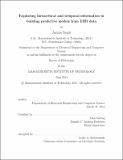| dc.contributor.advisor | John Guttag. | en_US |
| dc.contributor.author | Singh, Anima, Ph. D. Massachusetts Institute of Technology | en_US |
| dc.contributor.other | Massachusetts Institute of Technology. Department of Electrical Engineering and Computer Science. | en_US |
| dc.date.accessioned | 2015-11-09T19:12:53Z | |
| dc.date.available | 2015-11-09T19:12:53Z | |
| dc.date.copyright | 2015 | en_US |
| dc.date.issued | 2015 | en_US |
| dc.identifier.uri | http://hdl.handle.net/1721.1/99783 | |
| dc.description | Thesis: Ph. D., Massachusetts Institute of Technology, Department of Electrical Engineering and Computer Science, 2015. | en_US |
| dc.description | This electronic version was submitted by the student author. The certified thesis is available in the Institute Archives and Special Collections. | en_US |
| dc.description | Cataloged from student-submitted PDF version of thesis. | en_US |
| dc.description | Includes bibliographical references (pages 123-126). | en_US |
| dc.description.abstract | Clinical predictive modeling has the potential to revolutionize healthcare by allowing caregivers to allocate resources effectively, resulting not only in lower costs but also in better patient outcomes. Electronic health records (EHR), which contain large volumes of detailed patient information, are a great resource for learning accurate predictive models using advanced machine learning and data mining techniques. In this thesis we develop techniques that can exploit available patient information to learn clinical predictive models while tackling the challenges inherent in the data. We present our work in the context of predicting disease progression in chronic diseases. We present a novel feature representation that exploits hierarchical relationships between high cardinality categorical variables to tackle the challenge of high dimensionality. Our approach reduces feature dimensionality while maintaining variable-specific predictive information to yield more accurate predictive models than methods that ignore the hierarchy. For predicting incident heart failure, we show that by leveraging hierarchy in the diagnosis and procedure codes, we can improve the area under the receiver operating characteristic curve from 0.65 to 0.70 and the F-score from 0.37 to 0.40. Using simulation, we further analyzed the properties of the data that affect the amount of improvement obtained by leveraging hierarchy. We also present a method to exploit temporal information in longitudinal EHR data. Our multitask-based machine learning approach captures time varying effects of a predictor. Our results show that by exploiting temporal information, our approach can improve risk stratification of patients with compromised kidney function over a model that only use the most recent patient information. Specifically, our proposed approach is able to boost sensitivity from 37.5% to 55.1% (for a precision of ~~ 50%) when identifying patients at high risk of rapid progression of renal dysfunction. | en_US |
| dc.description.statementofresponsibility | by Anima Singh. | en_US |
| dc.format.extent | 126 pages | en_US |
| dc.language.iso | eng | en_US |
| dc.publisher | Massachusetts Institute of Technology | en_US |
| dc.rights | M.I.T. theses are protected by copyright. They may be viewed from this source for any purpose, but reproduction or distribution in any format is prohibited without written permission. See provided URL for inquiries about permission. | en_US |
| dc.rights.uri | http://dspace.mit.edu/handle/1721.1/7582 | en_US |
| dc.subject | Electrical Engineering and Computer Science. | en_US |
| dc.title | Exploiting hierarchical and temporal information in building predictive models from EHR data | en_US |
| dc.type | Thesis | en_US |
| dc.description.degree | Ph. D. | en_US |
| dc.contributor.department | Massachusetts Institute of Technology. Department of Electrical Engineering and Computer Science | |
| dc.identifier.oclc | 927413978 | en_US |
